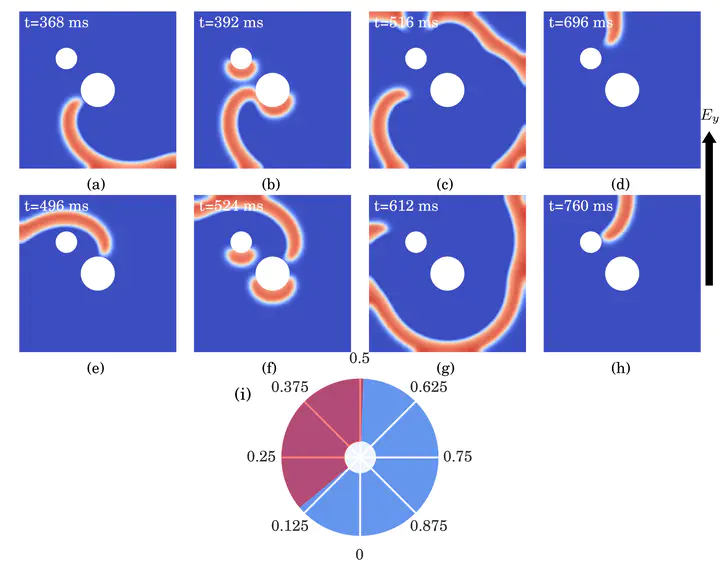Spiral wave unpinning facilitated by wave emitting sites in cardiac monolayers

Rotating spiral waves are often
associated with functional disorders in physiological tissue, like reentrant
electrical activity in the heart during cardiac
arrhythmias. Therefore, it is essential to devise methods to
eliminate them. But rotating waves in heterogeneous excitable media
tend to attach to heterogeneities (or obstacles) and form stable pinned
waves. These pinned waves have to be unpinned first to be able to eliminate them.
They can be unpinned if an electric stimulus is delivered very close to the pinning centre
and within a specific time interval called the unpinning window, i.e., the stimulus has to be within a narrow spatial and temporal
window.
Recently, many groups have started using periodic field pulses to increase the chances of unpinning. The idea here is to fire multiple pulses at a rotating spiral and hope one pulse would fall into the unpinning window and eliminate the pinned spiral. Studies so far have focused on unpinning a rotating wave by secondary excitations emanating from the obstacle itself. However, these studies show that unpinning window is quite narrow compared to the experimental studies on the intact heart. So far, the larger width of the unpinning window in the intact heart is attributed to its 3D structure. However, we hypothesised that if an additional obstacle is put close to the existing obstacle, the collective width of their unpinning window must increase. This induced us to study the role of multiple wave emitting sites in the unpinning process. Also, multiple heterogeneities in close vicinity offer the possibility of additional stimulus sites and additional anchoring sites. In such cases, one needs to examine how the distribution of heterogeneities modifies the unpinning window. Despite their critical importance in low-energy anti-fibrillation techniques, this problem has not received much attention. We study how these additional obstacles can alter the unpinning of a single spiral.
In this project, we show that secondary excitations emanating from nearby heterogeneities can unpin a wave attached in the vicinity in monolayers of cardiac cells. We then undertake a detailed numerical study of the wave unpinning in the presence of two heterogeneities. We found that the unpinning window either increases or decreases in the presence of additional heterogeneity. Their influence depends on their orientation with respect to the electric field, distance from the obstacle, and size. Along certain orientations, unpinning completely fails.
The figure shows success and failure of unpinning of spiral pinned to an obstacle in the presence of the additional wave emitting site. Black vertical arrow on the right indicates the direction of applied electric field of strength $E_{0} = 1.2$ V/cm. (a) Spiral is pinned to an obstacle of radius 3 mm with second obstacle of radius 2 mm nearby. (b) Nucleation of secondary excitation by the application of short timed pulse. (c-d) Detachment of the original spiral from the obstacle resulting in successful unpinning. (e) Spiral wave pinned to the central obstacle at a different initial phase. (h) The spiral getting pinned back to the second obstacle leading to failure of unpinning. (i) The unpinning window for the above configuration of the obstacles.